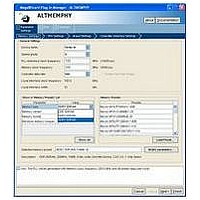IPR-HPMCII Altera, IPR-HPMCII Datasheet - Page 90

IPR-HPMCII
Manufacturer Part Number
IPR-HPMCII
Description
IP CORE Renewal Of IP-HPMCII
Manufacturer
Altera
Datasheet
1.IP-HPMCII.pdf
(176 pages)
Specifications of IPR-HPMCII
Software Application
IP CORE, Memory Controllers, SDRAM
Supported Families
Arria II GX, HardCopy III, Stratix III, Stratix IV
Core Architecture
FPGA
Core Sub-architecture
Arria, HardCopy, Stratix
Rohs Compliant
NA
Lead Free Status / RoHS Status
na
- Current page: 90 of 176
- Download datasheet (4Mb)
5–38
Using a Custom Controller
External Memory Interface Handbook Volume 3
Section II. DDR3 SDRAM Controller with ALTMEMPHY IP User Guide
1
The ALTMEMPHY megafunction can be integrated with your own controller. This
section describes the interface requirement and the handshake mechanism for
efficient read and write transactions.
Preliminary Steps
Perform the following steps to generate the ALTMEMPHY megafunction:
1. If you are creating a custom DDR3 SDRAM controller, generate the Altera
2. Compile and verify the timing. This step is optional; refer to
3. If targeting a DDR3 SDRAM device, simulate the high-performance controller
4. Integrate the top-level ALTMEMPHY design with your controller. If you started
5. Compile and simulate the whole interface to ensure that you are driving the PHY
Design Considerations
This section discuss the important considerations for implementing your own
controller with the ALTMEMPHY megafunction. This section describes the design
considerations for AFI variants.
Simulating the high-performance controller is useful if you do not know how to drive
the PHY signals.
Clocks and Resets
The ALTMEMPHY megafunction automatically generates a PLL instance, but you
must still provide the reference clock input (pll_ref_clk) with a clock of the
frequency that you specified in the MegaWizard Plug-In Manager. An active-low
global reset input is also provided, which you can deassert asynchronously. The clock
and reset management logic synchronizes this reset to the appropriate clock domains
inside the ALTMEMPHY megafunction.
A clock output, half the memory clock frequency for a half-rate controller, is provided
and all inputs and outputs of the ALTMEMPHY megafunction are synchronous to
this clock. For AFIs, this signal is called ctl_clk.
There is also an active-low synchronous reset output signal provided, ctl_reset_n.
This signal is synchronously de-asserted with respect to the ctl_clk or phy_clk clock
domain and it can reset any additional user logic on that clock domain.
high-performance controller targeting your chosen Altera and memory devices.
Simulating” on page
design so you can determine how to drive the PHY signals using your own
controller.
with the high-performance controller, the PHY variation name is
<controller_name>_phy.v/.vhd. Details about integrating your controller with
Altera’s ALTMEMPHY megafunction are described in the following sections.
properly and that your commands are recognized by the memory device.
4–1.
Chapter 5: Functional Description—ALTMEMPHY
December 2010 Altera Corporation
“Compiling and
Using a Custom Controller
Related parts for IPR-HPMCII
Image
Part Number
Description
Manufacturer
Datasheet
Request
R

Part Number:
Description:
IP NIOS II MEGACORE RENEW
Manufacturer:
Altera
Datasheet:

Part Number:
Description:
IP CORE Renewal Of IP-XAUIPCS
Manufacturer:
Altera
Datasheet:

Part Number:
Description:
IP CORE Renewal Of IP-10GETHERNET
Manufacturer:
Altera
Datasheet:

Part Number:
Description:
IP CORE Renewal Of IP-ASI
Manufacturer:
Altera
Datasheet:

Part Number:
Description:
IP CORE Renewal Of IP-CIC
Manufacturer:
Altera
Datasheet:

Part Number:
Description:
IP CORE Renewal Of IP-CRC
Manufacturer:
Altera
Datasheet:

Part Number:
Description:
IP CORE Renewal Of IP-ED8B10B
Manufacturer:
Altera
Datasheet:

Part Number:
Description:
CPLD, EP610 Family, ECMOS Process, 300 Gates, 16 Macro Cells, 16 Reg., 16 User I/Os, 5V Supply, 35 Speed Grade, 24DIP
Manufacturer:
Altera Corporation
Datasheet:

Part Number:
Description:
CPLD, EP610 Family, ECMOS Process, 300 Gates, 16 Macro Cells, 16 Reg., 16 User I/Os, 5V Supply, 15 Speed Grade, 24DIP
Manufacturer:
Altera Corporation
Datasheet:

Part Number:
Description:
Manufacturer:
Altera Corporation
Datasheet:










